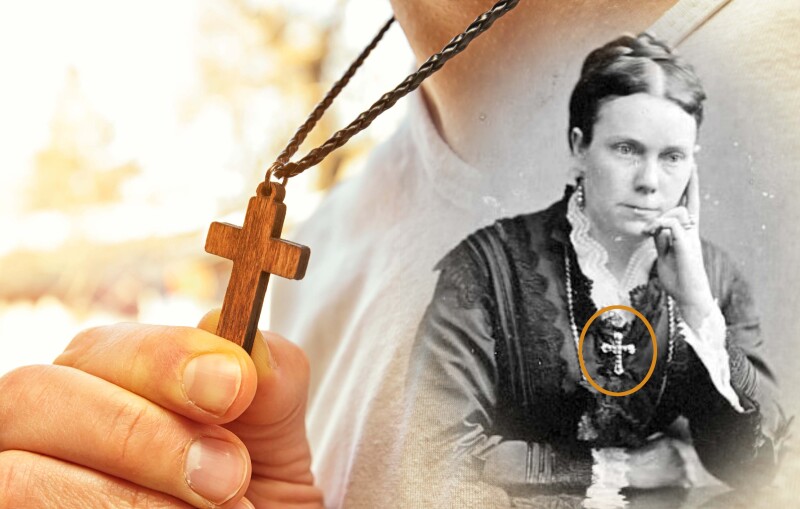Recently a Latter-day Saint woman shared the following story with me. She lived in the southern United States and invited a neighbor of another faith to attend her daughter’s baptism. The neighbor accepted the invitation and came to witness the ordinance. Afterward she graciously presented the 8-year-old with a gift: a cross necklace. Upon opening the gift, the child froze. She had been taught not to wear crosses. The mother also froze, feeling unsure out how to respond. Sensing the mother and daughter’s discomfort, the neighbor hastily took back the cross, promising to get the child a different gift.
Today, that Latter-day Saint mother looks back on this experience with regret, wishing she had seen it as an opportunity to rejoice with her friend in their shared belief in Jesus Christ instead of letting it be a source of discomfort and division.
Experiences like these might make some wonder: What has the Church actually said about wearing the cross? Have Church leaders encouraged us not to participate in the practice? How should we view other Christians and even fellow Latter-day Saints who use the symbol?
Let’s explore these questions by examining any current, official Church statements; the historical viewpoints of early Latter-day Saints; and any statements made by Church leaders over time until the present. I’ll also share experiences that others have shared with me to help bring personal perspectives to the topic about why the cross is a beautiful reminder of Christ’s atoning sacrifice.
Official Church Statements
A look at current, official Church publications shows that very little has been said about wearing the cross, either in favor of the practice or against it. So far as I have been able to ascertain, no Church handbook has either forbidden or encouraged the use of the cross.
We do, however, have a Gospel Topics article about the cross. It acknowledges that “the cross is used in many Christian churches as a symbol of the Savior’s death and Resurrection and as a sincere expression of faith.” It goes on to say that “as members of The Church of Jesus Christ of Latter-day Saints, we also remember with reverence the suffering of the Savior. But because the Savior lives, we do not use the symbol of His death as the symbol of our faith.”
This article attests that the Church itself does not use the cross as a symbol of our faith; however, it doesn’t specifically say whether individuals should or should not wear one.
As far as I can ascertain, this is the most official and current comment from the Church on the subject. While some Church leaders have made additional statements either in private or in non-Church publications, these may not carry the same weight. We’ll take a look at some of these sources later. First, let’s discuss the viewpoints of early Church members to give some context.
Historical Viewpoints
The Church’s view of the cross as a symbol has a rich and complex history. Early Church members did not eschew the cross: in the 19th century, Latter-day Saint marriage certificates, quilts, and funeral programs sometimes featured crosses, as did the 1852 European edition of the Doctrine and Covenants.
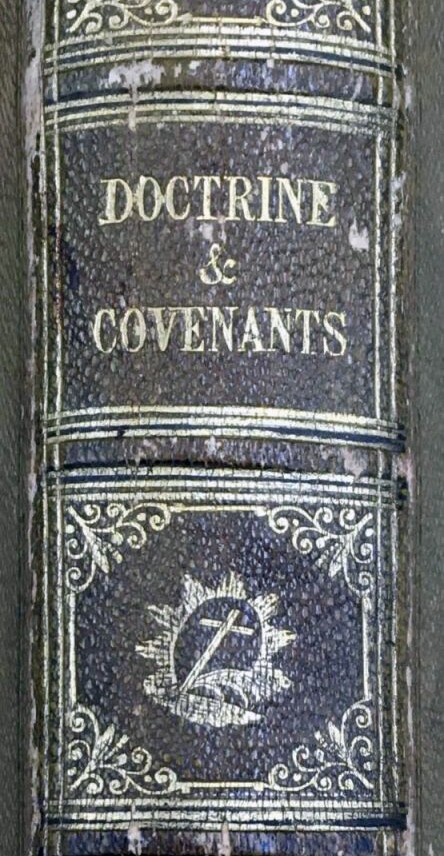
Crosses were displayed at the funerals of prominent Church members such as Eliza R. Snow and John Taylor,1 and even Latter-day Saint church buildings sometimes—though rarely—featured crosses, a practice that continues to the current day.2
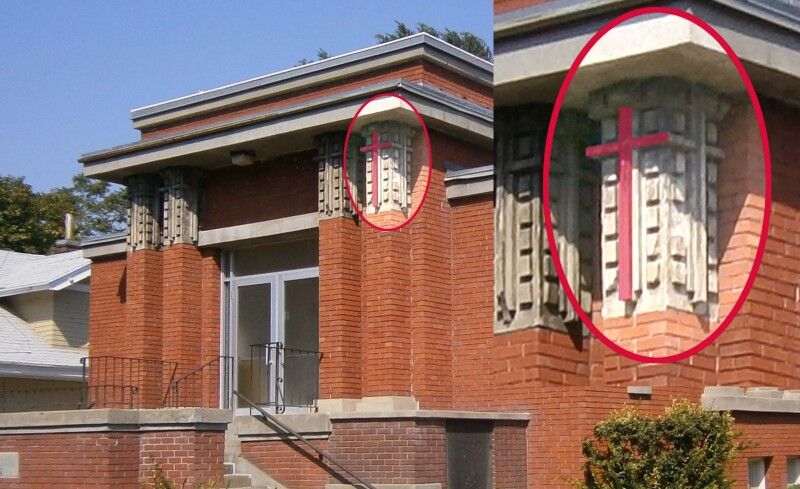
Early photographs indicate that prominent Latter-day Saint men and women wore jewelry featuring the cross, including Amelia Folsom Young, wife of Brigham Young; and Nabby Young Clawson, Brigham Young’s daughter (see image below).3
Males, including Benjamin F. Johnson (a former secretary to Joseph Smith), also wore crosses on watch chains or ties.4 The fact that so many early members wore such accessories when posing for formal photographs indicates that cross jewelry was relatively common. At that time there was nothing particularly unusual about Latter-day Saints wearing a cross.
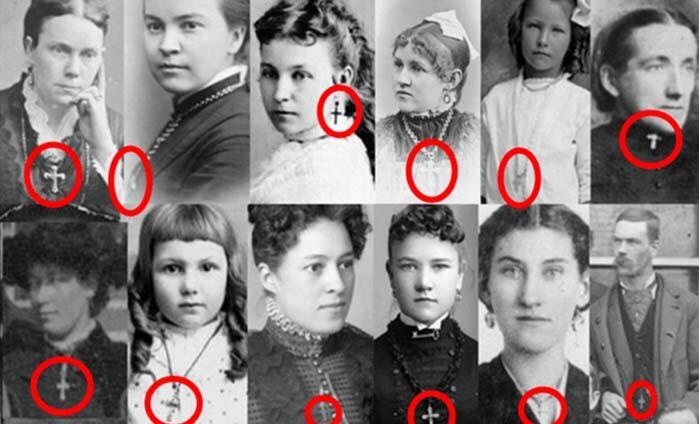
One of the best indicators of the early Church’s openness to the image of the cross in the early 20th century is the proposal to build a large cross monument on Ensign Peak in Salt Lake City. In 1916, Presiding Bishop Charles W. Nibley proposed that the Church have “the privilege of erecting on Ensign peak a suitable cross, the symbol of Christianity, as a memorial to the ‘Mormon’ pioneers who first established here that which the cross implies.”5
President Joseph F. Smith and one of his counselors in the First Presidency both agreed that putting a cross on Ensign Peak was a good idea.6 Speaking of the proposal, the Deseret Evening News stated, “The monument is intended as an insignia of Christian belief on the part of the Church which has been accused of not believing in Christianity.”7
However, some people in the Salt Lake Valley opposed the monument. Local rabbis argued that a cross failed to represent the multiple faiths in Utah, and some Church members inaccurately claimed it was a Catholic symbol.8 The project was ultimately shelved, but the fact that it was approved by the President of the Church indicates that during this time the cross was not viewed as an inappropriate symbol for the faith.
Use of the cross continued into the 20th century. The headstone of Elder B. H. Roberts of the Seventy, who died in 1933, was inscribed with a large cross.9
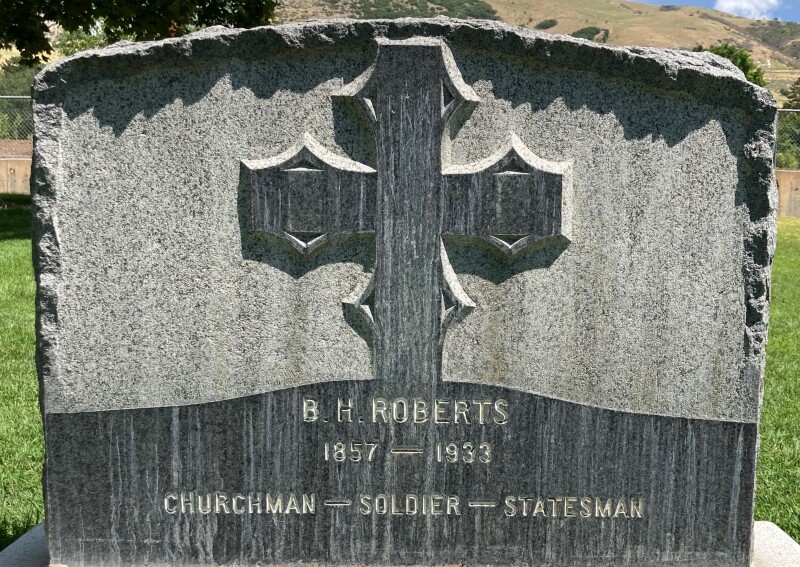
In addition, during the 1940s, a large stone cross was erected in Provo, Utah, near Y Mountain. Several stakes, together with Brigham Young University, sponsored interdenominational Easter services held at the cross.10 In this same decade, Spencer W. Kimball shared experiences indicating he perceived the cross as a positive religious symbol.11
Shifting Perspectives
In the 1950s a shift began to take place in how some Church members viewed the cross. Much of this shift appears to come from an increased association of the cross with Catholicism. During this decade, President David O. McKay wrote in his private journal that he felt Latter-day Saint girls should not wear crosses.12
When searching general conference talks and other published writings of General Authorities,13 I have been able to locate only three statements that speak about wearing or displaying crosses, although none of them are from official Church publications.
In 1958 Elder Bruce R. McConkie wrote negatively about wearing a cross, saying it was ”inharmonious” with Latter-day Saint worship.14
Then in 1961, Elder Joseph Fielding Smith wrote, “If our Lord had been killed with a dagger or with a sword, it would have been very strange if religious people this day would have graced such a weapon by wearing and adoring it because it was by such a means that our Lord was put to death.”15 He went on to say that “the wearing of crosses is to most Latter-day Saints in very poor taste and inconsistent to our worship.”16
Finally, in 1990 Elder Marvin J. Ashton more softly wrote, “We … try to teach our people to carry their crosses rather than display or wear them.”17
It’s interesting to note that these few unofficial statements discouraging Church members from wearing or displaying crosses are decades old. Clearly, we should follow the counsel of living prophets, seers, and revelators; however, we should remember that specific practices and applications can shift over time.
A Multifaceted Symbol
In the same article in which he wrote that “the wearing of crosses is to most Latter-day Saints in very poor taste,” President Joseph Fielding Smith nonetheless acknowledged that for many religious people, the symbol could be helpful: “We have never questioned the sincerity of Catholics and Protestants for wearing the cross, or felt that they were doing something which was wrong.” He continued, “The motive for such a custom by those who are of other churches, we must conclude, is a most sincere and sacred gesture. To them the cross does not represent an emblem of torture but evidently carried the impression of sacrifice and suffering endured by the Son of God.”18
This statement illustrates that how one views the image of a cross can vary. Some Latter-day Saints may agree with President Smith’s words that a cross necklace might be “in very poor taste,” while others might agree with his statement that a cross could represent the sacred “sacrifice and suffering endured by the Son of God.”
In a 1975 conference talk, President Gordon B. Hinckley explained the Church’s institutional practice of not having crosses in our buildings, but he did not directly discourage individuals from wearing or displaying crosses. In that talk, President Hinckley related how a Protestant minister asked him how Latter-day Saints could claim to be Christians while avoiding the image of the cross.
President Hinckley responded, “I do not wish to give offense to any of my Christian brethren who use the cross on the steeples of their cathedrals and at the altars of their chapels, who wear it on their vestments, and imprint it on their books and other literature. But for us, the cross is the symbol of the dying Christ, while our message is a declaration of the living Christ.” He continued, “The lives of our people must become the only meaningful expression of our faith and, in fact, therefore, the symbol of our worship.”19
President Hinckley’s statement emphasizes the worship of the living Christ—the importance of which cannot be overstated. At the same time, if we as members insist that the cross must exclusively represent a dying Jesus Christ, we ignore the fact that this symbol, like so many others, is multifaceted: symbols permit, even invite, layers of meaning.
To insist that our fellow Christians focus on Christ’s death by wearing a cross would be shortsighted, as illustrated by this experience of Eric Huntsman, professor of ancient scripture at Brigham Young University:
“I remember being surprised once when a … Presbyterian friend corrected me when I told her that we preferred to worship a living rather than a dead Christ; she responded that she did too. The cross reminded Protestants that Jesus died for their sins, but it was empty because He was risen and was no longer there on it. I was chastened by her response, realizing that just as we do not appreciate others mischaracterizing our beliefs, neither should we presume to understand or misrepresent the beliefs and practices of others.”20
In the 21st century, we have started to see some Church leaders commenting positively on the influence that crucifixion imagery can have. For example, Elder Edward Dube of the Seventy has said that one of the “defining moments” in his life occurred when he was pondering an image of the Crucifixion in a Catholic church in his native country of Zimbabwe when he was 10 years old.21 For Elder Dube, viewing the image of Christ on the cross was a moving, spiritual experience.
Before Elder F. Enzio Busche of the Seventy joined the Church, he was hospitalized with a serious liver infection. Believing he was about to die, he began to panic, realizing that he had not prepared himself to meet God. He wrote, “On the wall of my [hospital] room was a cross with the crucified Christ on it. It was the only object on the wall, and as I focused upon it, I developed a tremendous hope.”22
A Question of Culture, Not Doctrine
To be clear: No Church statement has ever encouraged Latter-day Saints wear or display crosses. At the same time, no Church teachings should be used to judge or stigmatize those who do wear or display a cross.
Consider my friend’s experience—while I’m not suggesting we all need to do exactly what he did, I admire his willingness to defend others’ perspectives. He recounts:
“While I was serving in a bishopric, a family got baptized. The Primary-age girl came to church following her baptism wearing a cross necklace. Her grandma, who was not yet baptized, also came to church wearing a cross necklace.
“During a [later] visit with this family, they shared with me that the Primary-age girl was told by one of her classmates, ‘You shouldn’t wear that cross. It’s bad.’ The grandma was also told by an adult church member, ‘You shouldn’t wear that necklace at our church.’
“I asked the girl and her grandma to tell me why they wore the cross. They shared with me their gratitude for the sacrifice Jesus made for them. I told them, ‘Please continue to wear your necklaces. I will wear the symbol of the cross on Sunday as well.’ I purchased a pair of cross cufflinks and wore them each Sunday to church.
“On occasion I was asked by members of the ward about my cross cufflinks. One asked me, ‘Why would you wear a symbol of Christ’s death?’
“I answered, ‘The cross is not a symbol of death. It is a symbol of life. It is a symbol of the Savior’s triumph over death.’
“The member replied, ‘I have never thought of it like that.’
I’m grateful my friend was there to ease the pain of some people who could easily have been offended at the way they were treated. I wonder how many visitors or recent converts have left the church because of unnecessary comments made about a cross they displayed or wore. It doesn’t have to be that way.
The meaning of the symbol of the cross is more cultural than doctrinal; therefore, we should avoid making it an issue when fellow Latter-day Saints or other Christians use the symbol to remind themselves of Jesus Christ.
Whatever you personally think about the cross as a symbol, remember that no Church leader has made an official statement that members should not wear or display crosses. No Church handbook has ever forbidden this practice. For some the cross represents death, but for others it represents life and love. Understanding the multifaceted meanings of the cross can help us feel more love for Jesus and more deeply feel His love for us.
More articles in this series:
Notes
- Michael G. Reed, Banishing the Cross: The Emergence of a Mormon Taboo (Independence, MO: John Whitmer Books, 2012), 76–78.
- Reed, Banishing the Cross, 73–74. At least one modern Church building, in Tennessee, features a cross. The building was purchased from a Christian denomination, and the cross was left intact:

- These images, along with several others are found in Reed, Banishing the Cross.
- Reed, Banishing the Cross, 80–83.
- Reed, Banishing the Cross, 87.
- Reed, Banishing the Cross, 87–92.
- Deseret Evening News, May 5, 1916, 2, cited in Ronald W. Walker, “A Gauge of the Times: Ensign Peak in the Twentieth Century,” Utah Historical Quarterly 62, no. 1 (1994):14.
- Reed, Banishing the Cross, 88–92.
- Reed, Banishing the Cross, 110–11.
- D. Robert Carter, “Worshiping at the Easter Cross,” Daily Herald (Provo, UT), March 27, 2005.
- See Edward L. Kimball and Andrew E. Kimball, Spencer W. Kimball: Twelfth President of the Church of Jesus Christ of Latter-day Saints (Salt Lake City: Bookcraft, 1977), 194
- David O. McKay, diary, April 29, 1957, cited in Reed, Banishing the Cross, 115–16.
- I searched the GospeLink database (gospelink.com/), which contains thousands of Church-related publications.
- Bruce R. McConkie, Mormon Doctrine (Salt Lake City: Bookcraft, 1958), 160. This statement also appeared in subsequent editions of Mormon Doctrine.
- Joseph Fielding Smith, “The Wearing of the Cross,” Improvement Era, March 1961, 144. President Smith’s remarks were republished in Joseph Fielding Smith, Answers to Gospel Questions, vol. 4 (Salt Lake City: Deseret Book, 1963), 17–18. This viewpoint echoes a similar statement from C. H. Spurgeon, an influential nineteenth-century Baptist preacher. See The Complete Works of C. H. Spurgeon, vol. 14, Sermons 788 to 847 (Woodstock, Ontario: Devoted Publishing, 2017), 326.
- Smith, “Wearing of the Cross,” 144.
- Marvin J. Ashton, Be of Good Cheer (Salt Lake City: Deseret Book, 1990), 31.
- Smith, “Wearing of the Cross,” 144.
- Gordon B. Hinckley, “The Symbol of Christ,” Ensign, May 1975, emphasis added. This talk was slightly modified to become a First Presidency message in the April 2005 Ensign and also appears in the March 1989, April 1990, and April 1994 editions of the Liahona. This phrase has been quoted more than twenty times in Church magazines, manuals, and other writings of Church leaders. Elders M. Russell Ballard and Bruce D. Porter have also made statements similar to President Hinckley’s regarding why the Church does not use the cross as a symbol. See M. Russell Ballard, Our Search for Happiness: An Invitation to Understand The Church of Jesus Christ of Latter-day Saints (1993), 13–14; Bruce D. Porter, The King of Kings (2000), 91.
- Eric D. Huntsman, “Preaching Jesus, and Him Crucified,” in His Majesty and Mission, ed. Nicholas J. Frederick and Keith J. Wilson (Provo, UT: Religious Studies Center, Brigham Young University; Salt Lake City: Deseret Book, 2017), 73.
- Edward Dube, “Gaining My Faith One Step at a Time,” New Era, April 2020.
- F. Enzio Busche and Tracie A. Lamb, Yearning for the Living God: Reflections from the Life of F. Enzio Busche (Salt Lake City: Deseret Book, 2004), 52.

